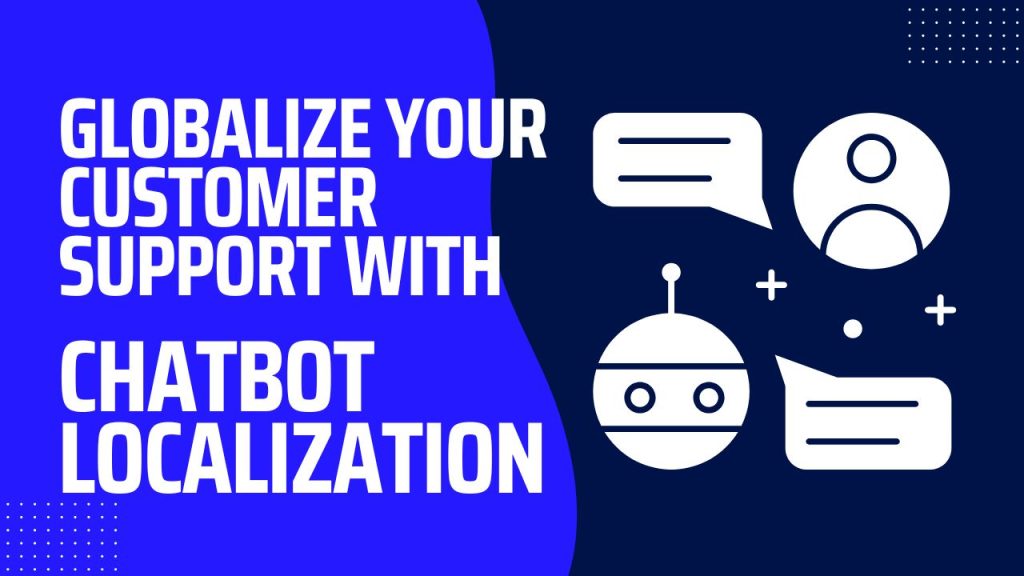
Does your chatbot sound like it’s from another country? Make your bot part of every customer’s community, wherever they are in the world, with the process of chatbot localization.
In modern online retail, the first line of customer support is often a chatbot or virtual assistant of some kind. Extending this support for a worldwide customer base, therefore, requires the AI-driven aide to be adapted to understand and respond to multiple languages and cultures.
Chatbots are essentially software applications used to conduct online exchanges by simulating human conversations. The software analyses the customer’s written or spoken input to identify the intent and generate a suitable response.
Chatbots are not typically intended to make customers believe they are conversing with another human. In fact, when that’s the effect, real humans don’t always appreciate the façade.
Still, accuracy and resposiveness are vital to their success.
To be effective, localization must encompass every interaction with the shopper. That ranges from product descriptions to customer support calls and any other touch points.
Why Localize Your Chatbot
Adapting online content for international markets is a business necessity for e-commerce companies. Anyone thinking they can sell globally without, at least, translating their content should consider the following statistic:
Over 80% of consumers won’t buy from a brand that doesn’t offer local language support, per a report released by RWS.
Simple translation is not enough. It takes little account of the context of the words and the culture of the target market. Instead, localization is required to create a shopping experience for each international market that feels as if it was created locally, just for them.
Online stores that fail to cater to the distinct needs and nature of individual markets are effectively blocking entry to a huge section of their potential customers. The same is true for sports betting apps and websites.
It’s important, therefore, that chatbots take cultural as well as linguistic diversity into account. For example the direction text is written in, local currency units, and systems of measurement.
The Benefits of Chatbot Localization
A business that is able to support the full diversity of its global customer base in a way that feels like the company behind the bot understands their specific needs will, inevitably, enjoy commercial advantages:
- Increased market size. Expanding access to support via a localized chatbot leads to more customers, more sales, and increased revenue. As the localized support improves relationships with local people. It can lead to them becoming ‘promoters’ of the brand, which subsequently leads to further market expansion.
- New commercial opportunities. Analyzing chatbot conversations can reveal demand in a market that you may be able to fulfil. Similarly, specific, regional customer issues can be identified and addressed.
- A competitive edge. Being able to converse with customers in a way that is relevant to them and their community gives a business an immediate head start. This competitive edge can catapult a market entrant to the forefront of shoppers’ attention, as data shows that 56.2% of consumers will pay more for their goods if they can obtain the information they’re looking for in their native language.
- Improved cost-effectiveness. A multilingual chatbot is ‘at its desk’ every second of every day. The cost for an equivalent customer support service provided by humans would be huge, not to mention the outlay in time and money hiring and training suitable staff. Chatbot technology being relatively new, but, by 2027, chatbots will become the primary customer service channel for roughly a quarter of organizations, according to Gartner, Inc.
The difference between asking a fully localized chatbot for information versus a basic, translated chatbot is like asking a knowledgeable neighbor for driving directions versus a tourist.
If you want to steer customers towards the checkout, they need the right answers.
What Makes a Chatbot Successful?
As well as the obvious characteristics of a high-performing chatbot, such as a comprehensive database of accurate information, here are the three qualities of a great chatbot.
1. Effortless language selection
Customers don’t want to deal with the default language before they select their preferred language from a list. Instead, they should either be presented with language options immediately on entering the sight, or, ideally, have the chatbot automatically detect their language without them even noticing.
2. No give-away errors
When a chatbot is adapted for a new region, it is very easy for unnatural text to enter the discourse, particularly when special characters, such as currency symbols and quotation marks, are involved. Careful attention to detail is essential to avoid such mistakes.
3. Personalized responses
If the aim of your site is to make customers feel at ease and looked after, your chatbot needs to build a good relationship with the user. Personalizing the exchange involves such conversational niceties as using the inquirer’s name, remembering if they have used the chatbot before, and recalling their previous order history.
Where Cutting-Edge Tech Meets Conversational Speech
Whether you’re building a chatbot, voice assistant, or speech-enabled device, understanding text data is crucial for a seamless user experience.
Summa Linguae Technologies offers multilingual text data from a wide variety of sources to help power your chatbot’s conversational AI.
Our datasets have been collected, dusted, and are now available to you off the shelf. But this isn’t just data. It’s a catalyst for accelerating the development, building, training, and testing of your multilingual AI models.
Tell us about your project and we’ll recommend a data set or tailor a data collection plan to your exact needs.
We also offer chatbot localization services to help you create a customer experience that’s just as good in any language. We work with you to understand your unique localization needs and will support you throughout the entire development process.
This includes advising on localization best practices, chatbot text translation, lexicon development, collecting data, and localization testing.
For smarter chatbots, chat with a Summa Linguae Technologies human today.


